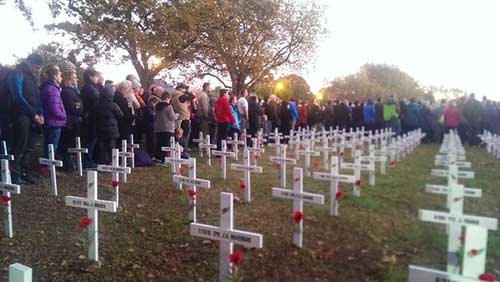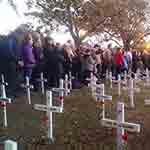
Yesterday I went to the ANZAC Dawn Service.
For those unfamiliar with this, ANZAC stands for Australian and New Zealand Army Corps. The ANZAC force landed at Gallipoli (Turkey) on 25 April 1915.
After the First World War, returned soldiers sought the comradeship they felt in those quiet, peaceful moments before dawn. With symbolic links to the dawn landing at Gallipoli, a dawn stand-to or dawn ceremony became a common form of Anzac Day remembrance during the 1920s.
By the 1970s, attendance and significance was dwindling – but from the 1980s, numbers have grown from strength to strength.
Thousands were gathered before dawn – every generation was well represented. Young parents brought toddlers in strollers or carried them; the elderly were accompanied by grandchildren. The service took about three-quarters of an hour. There was ceremony, speeches, hymns, three national anthems, prayers, the Lord’s Prayer, and silence.
Some reflections – in no particular order:
The children, without exception, behaved impeccably. They picked up the sense of occasion and were present with dignity. Compare that with children in church services – if a parish is “lucky” enough to have any children present. They will be taken out for a significant time for a fun activity; there will be a play area specially set up within the worship space; there will be a soundproof room where they can be noisy;… The concept that the single event of worship is for all ages and all stages still struggles in many, many places. In some places adults worship; children learn. Yet go to a monastery, or marae, or an ANZAC Dawn Service and you see children fitting in with everyone else, all being there together because of the expectation and culture and the seriousness with which all is being done.
We are not a singing or a responding culture. The words were clearly visible on a large screen, but generally very few joined in with singing, saying the Lord’s Prayer, or even repeating “We will remember them” as is the custom at the end of The Ode of Remembrance. Two things spring to mind: is this behind the growth of “spectator services”? Cathedral worship, where essentially everything is done by a choir and people up front, is one of the few signs of church growth in English culture. I want to hold to “participatory worship” where we all do everything together (led by individuals and a choir, sure), but maybe this is an area where church is counter-cultural.
There was no attempt to “update” – no rock band, no gimmicks, nothing done to attract crowds, or to make it more “relevant”…
What makes the people come? What makes the young families drag kids out of bed just after five in the morning, dress them, and drive to a place where they stand in the cold and dark? This sounds like a good topic for some research – I wouldn’t be surprised if some had already been done. Sure, some churches have good and all-generation attendance, but I don’t think most of these people here at the ANZAC Service are church-goers. What makes them come to this “churchy” event, but not to church? There is a connection made between the tragedy of the Gallipoli disaster and the birth of a sense of nationhood. Is this, then, a ritualised enactment of our national creation story? Is this an inchoate expression of a yearning for meaning, here? Are many of these people looking for what church could provide – but often we don’t because we have lost confidence in our own tradition? Or we do provide it to our shrinking club, but we have lost confidence to let others know about it?
What thoughts spring to your mind?
If you appreciated this post, do remember to like the liturgy facebook page, use the RSS feed, and sign up for a not-very-often email, …




After moving to Australia a year and a half ago, ANZAC Day is new to me, but many of its elements are familiar. Here in Perth there seems to be a push to secularise the ceremony by removing hymns and prayers. I imagine that these were present without thought for the older generations of returned servicemen and -women, but that the post-Vietnam RSL is less comfortable with them. Perhaps they see the larger crowds each year and realise that the national myth-making in which they mostly subconsciously participate has become more dominant than religion.
The elements are redolent with powerful symbolism, but no one stops to explain them. And while the ceremonial might not be as tightly coordinated as I thought and the speeches mostly lacking any rhetorical skill (compare the French PM at Villers-Bretonneux), a captivating seriousness runs through it. It makes me wonder how churches present sacraments and gospel clouded by the explanations of potted theology and with an air of joviality that easily undermines seriousness.
We should be church outside the building more, present the symbols of the faith so that they speak powerfully rather than get watered down by our interpretations, and foster an air of seriousness about what we do and say.
Amen to all that, Gareth. I am regularly at services where the leader articulates ‘stage directions’: “Now I am going to do this…” – rather than simply doing it. And deep symbols are flattened by, “This means that…” And as for making jokes in a service about what, in a theology class, we would say is a serious moment – and at the very moment of doing this ‘serious’ stuff – yes, it punches me in the stomach every time. Don’t get me wrong: I have a strong sense of humour – at the Monty Python end of the spectrum – and let’s be able to laugh in church. But let’s also show we are serious what, in theory, we say we are serious about. Easter Season Blessings.
Truly powerful symbolism,even during 1st use, shouldn’t need to be explained. It’s someone’s weak, faux symbolism that needs to be explained.
Yes, David. I understood Gareth as saying that in a positive way: too often, in our churches, people weaken the power of our symbols by flattening them with explanation. Easter Season Blessings.
My wife and visited New Zealand and Australia two years ago during Eastertide. We were in Sydney for the ANZAC Day commemoration, tho we had seen advertisements and preparations for the day in other locations we visited. Overall, an impressive and moving commemoration. Glad we had the opportunity to be there then.
Very much like Remembrance Day in the UK, full churches and a higher than ever attendance at services around War Memorials. A huge civic occasion and an opportunity for people to remember those of their families who have made the sacrifice of their life, or who returned maimed or damaged for life.
In the UK, recent wars and the sight of bodies being returned and the visibility of damaged veterans on our streets, now not hidden away, but being celebrated in public, has brought a whole new generation to these services.
Yes, many might not have any connection with church, but many now know off or have had relatives killed or wounded or permanently damaged in recent wars, and people are more inclined to show up at ceremonies to remember them and the huge suffering involved.
For those, who describe it as flag waving nationalism, I point out that most of those who died in both world wars had little choice, they were conscripted, although many were volunteers – but many fought for their friends or families, not actually for a cause that they believed in.
As a veteran myself, I know what it means to lose friends, or seem them harmed and the sadness and despair of families left behind. Sitting in a house, with the family of a soldier killed in war is a profound, and deeply emotional experience – you can be overwhelmed by their display of grief, if you let your guard down. But you go away to do what is needed for repatriation services, funeral and memorials and support for the family, while quietly reviewing your own feelings. I have done that a number of times, and many others have as well.
We don’t glorify war, we are deeply anti-war and militarism -when I hear the patriotic drivel of some, who have never been in action or experienced it’s aftermath, I feel desperately sad.
Respect for the dead is something we need to remember, less it continues to happen. And in todays world, we could do with more peace makers, not war mongers.
Thanks, Ernie. Blessings.
I found this post moving and thought-provoking. Thank you.
There can’t be many worship sevices that are more solemn and no frills than the old style Open Brethren communion services I was privileged to share in when I was younger (unaccompanied singing;unrehearsed prayers; and uscripted ministry of the gospel). Nevertheless, the children attended and behaved,and most stayed in the Christian faith when they became adults.
I wonder if what kept them was this weekly exposure to a service whose purpose was to worship and glorify the Father for the salvation he gave us in his Son, and sealed to us by the Holy Spirit – a service not designed to entertain but to draw out of our hearts profound and reflective worship.
I believe that a formal liturgy can have the same kind of outcome if led by ministers who have the same understanding of the state of heart to which it should lead us, and the prayerful goal to indeed, by the Holy Spirit, lead us there. Is the problem, then, that we underestimate our children and older congregants and so deprive them of the opportunity to reach a beatitude that is seated deep in the core of their being, not just a short-lived, entertainment-evoked state?
Amen, Trevor. Easter Season Blessings.
As part of my Chaplaincy role in 3 local Rest Home Facilities, I coordinate an Anzac service in each every year. And it is interesting: many who don’t attend weekly worship are first to be there for Anzac. We don’t explain – no need. These elderly folk know what to do. We sing. We listen. We pray. We do all the familiar acts of remembrance. It never fails to move me deeply, as I’m allowed a glimpse into sacred memories – and grateful I’m old enough to know where they come from. Our powerful Easter message – Alleluia!